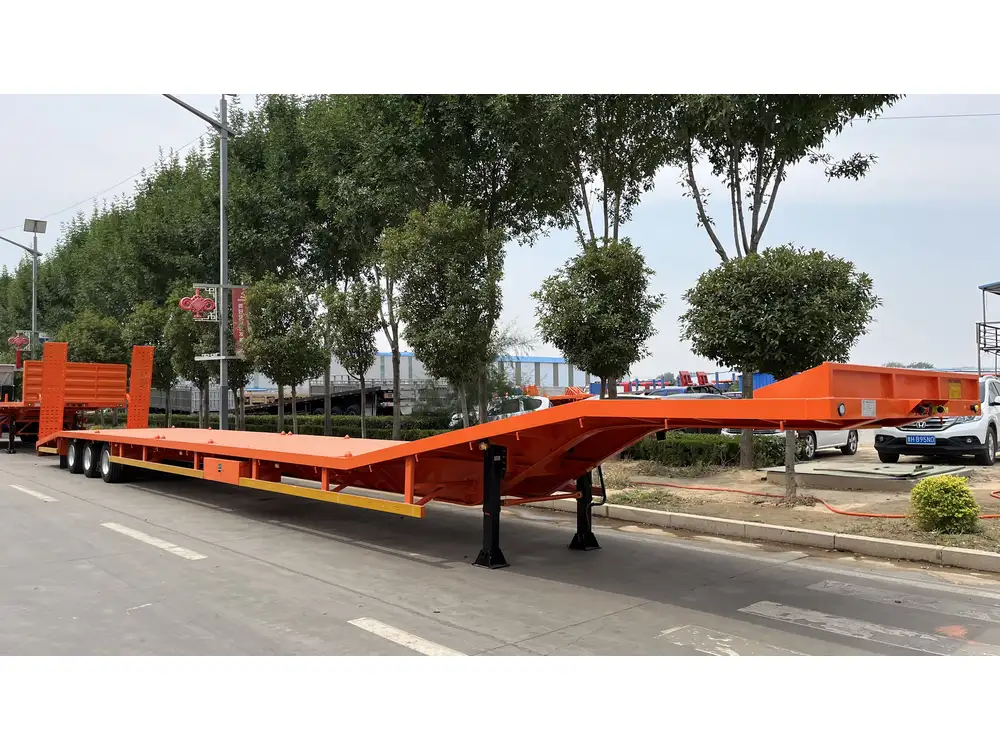Preparing an open trailer for dumping at Bayler is a multifaceted process that requires meticulous planning and attention to detail. This guide will provide manufacturers, operators, and users with the essential steps to ensure a smooth and effective dumping process, while adhering to safety standards and maximizing efficiency.
Understanding Open Trailers: Overview and Functionality
Open trailers are versatile transport solutions commonly used in various industries, including construction, landscaping, and waste management. These trailers are characterized by their unobstructed loading area, which allows for easy access to load and unload materials.
Key Features of Open Trailers:
| Feature | Description |
|---|---|
| Loading Capacity | Varies widely, typically ranging from 6,000 lbs to over 20,000 lbs depending on the trailer type. |
| Materials Compatible | Can transport loose materials, machinery, and even vehicles. |
| Towing Capability | Requires a suitable towing vehicle, typically requiring a Class III or higher hitch for larger trailers. |
| Construction Material | Commonly made from aluminum or steel for durability and longevity. |

Benefits of Using Open Trailers for Dumping:
- Increased Accessibility: Unobstructed access makes loading and unloading fast and efficient.
- Heightened Visibility: Easier monitoring of load during transport prevents spillage.
- Versatile Load Types: Ideal for various materials, including dirt, gravel, and demolition waste.
Steps for Preparing Your Open Trailer for Dumping
Inspect the Trailer Thoroughly
Ensure the integrity and readiness of the trailer before utilizing it for dumping. A thorough inspection should include the following:
- Structural Integrity: Check for cracks, rust, or bends in the frame and loading area.
- Hitch and Coupling Systems: Confirm that the hitch and coupling are secure and in good condition.
- Tires: Inspect the tires for proper inflation and tread wear.
Clean the Trailer
Effective preparation begins with a clean slate. Remove any remnants from previous loads that could cause contamination or issues during the dumping process.
- Use a high-pressure washer to clear out any debris lodged in the crevices.
- Ensure all sides and corners are free from moisture and materials that could lead to corrosion.
Safety Equipment and Compliance
Adhering to safety measures is non-negotiable when preparing an open trailer for dumping:
- Safety Straps and Tarps: Use safety straps to minimize movement of the load during transport. Effective tarping prevents material spillage.
- Safety Cones and Warning Lights: Deploy these safety devices around the dumping area to warn other workers and equipment operators.
- Personal Protective Equipment (PPE): Operators should wear appropriate PPE, including gloves and steel-toe boots, to prevent injuries.
Load Distribution and Weight Management
An essential factor during dumping preparation is load distribution. Follow these guidelines to ensure optimal stability:
Load Distribution Best Practices Even Distribution Center the load evenly across the trailer to maintain balance. Weight Limit Adhere strictly to the manufacturer’s specified weight limit to avoid overloading. Heavy Materials Place heavier items at the bottom of the load for a lower center of gravity. Positioning the Trailer
Selecting the right position at Bayler for the open trailer can significantly affect dumping efficiency. Considerations include:
- Accessibility: Ensure the trailer can easily access the dumping site without obstructions.
- Space and Surroundings: Make sure there’s enough room to maneuver without risking damage to equipment or surroundings.
Final Checks Before Dumping
Prior to executing the dumping process, there are crucial checks you must perform:
Verify Load Security: Double-check that your load is secured and stable.
Conduct a Final Inspection: Search for any signs of wear or potential hazards that could lead to accidents during the dumping process.
Communicate with Team Members: Ensure that everyone involved understands when and how the dumping will take place to avoid confusion.

The Dumping Process at Bayler
Now that your trailer is prepared effectively, executing the dumping process efficiently becomes paramount. Follow these pragmatic steps for a successful discharge of your load:
Step-by-Step Dumping Procedure
Position the Trailer: Drive the trailer into the designated dumping area at Bayler, aligning it correctly for maximum accessibility.
Activate the Dumping Mechanism: If your trailer is equipped with a hydraulic dumping feature, engage the mechanism carefully while keeping an eye on the load.
Monitor Load Release: As the materials begin to unload, watch for any irregularities and adjust as necessary to prevent spillage.
Pause and Assess: Once the load has been fully released, halt and assess the area for any residual materials that may need cleanup.
Secure the Trailer: Once the dump is complete, ensure that all dumping mechanisms are secured before preparing for the return trip.
Maintaining Your Open Trailer for Longevity
To ensure that your open trailer operates efficiently over time, follow these maintenance guidelines:
- Regular Inspections: Schedule periodic inspections, specifically focusing on tires, brakes, and structural integrity.
- Rust Protection: Apply appropriate coatings and treatments to protect against rust, especially if transporting corrosive materials.
- Cleaning: Frequently clean the trailer after each use, particularly after transporting materials that may lead to corrosion or damage.
| Maintenance Task | Frequency | Purpose |
|---|---|---|
| Tire Rotation | Every 5,000 miles | To extend tire life and ensure safety. |
| Brake Inspection | Monthly | To confirm optimal operation of trailer brakes. |
| Structural Inspection | Bi-annual | To prevent structural failures and enhance longevity. |

Conclusion
Mastering the art of preparing an open trailer for dumping at Bayler necessitates careful attention to details—right from the initial inspection to the final cleanup. By adhering to the outlined steps and maintaining safety and efficiency throughout the process, users can expect smoother operations and enhanced longevity of trailer usage.
Remember, preparation is the linchpin of success. Use this guide as a benchmark to streamline your open trailer operations, ensuring that both efficiency and safety are prioritized at every stage of the journey.



